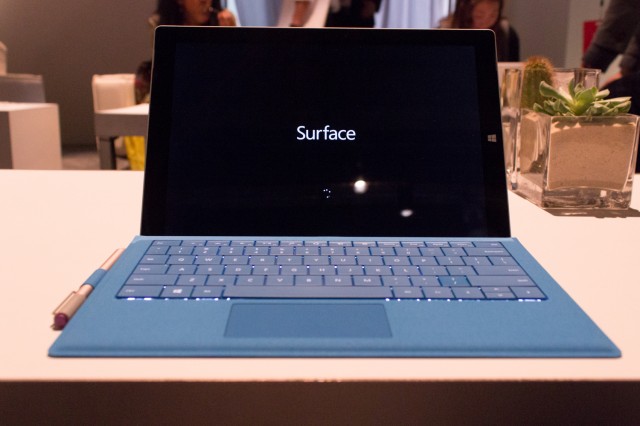
When Microsoft’s Surface event, held today in New York City, was first announced, the widespread expectation was that the company would be launching a Surface mini with an 8-inch screen and a Qualcomm ARM processor. What we got instead was a new 12-inch Surface Pro 3 with an Intel Haswell processor. The mini device, which just a few weeks ago was felt by many to be a certainty, was nowhere to be seen.
Bloomberg is reporting that, according to “people with knowledge of the decision,” the Surface mini was postponed at the last minute by Microsoft CEO Satya Nadella and Vice President Stephen Elop. The report says that the product wasn’t sufficiently differentiated from rivals and so “probably wouldn’t be a hit.” It’s worth noting that Bloomberg was one of the early proponents of the Surface mini theory, two weeks ago writing that the device would be released today “according to people with knowledge of [Microsoft’s] plans.”
Paul Thurrott, also well connected to company insiders, wrote just this morning that, based on plans he had seen, he expected the company to release both a Surface mini and a larger Surface Pro. Only one of those predictions came true. Thurrott offered a little more insight into the 8-inch device: in addition to its Qualcomm processor, the small tablet would lose the kickstand, come in a range of colors, and include pen support. The kickstand would instead be part of a separate cover.
Moreover, he says that the mini hardware has been more or less ready since last year. It wasn’t released at the same time as the Surface 2 and Surface Pro 2 because of production problems.
Mary Jo Foley agrees that the device exists and has been delayed, but she has different explanations for its non-release. First, she says that Terry Myerson, leader of Microsoft’s Operating System group, doesn’t like Windows RT and is waiting for a version of Windows that can run on both phones and tablets. Second, Microsoft’s entire Surface project is designed to fill gaps that the company’s OEM partners aren’t filling. With OEMs producing plenty of 8-inch Windows tablets, there’s little need for Microsoft to join them. This second point seems consistent with the lack of differentiation that Bloomberg notes.
In an interview, Microsoft’s Panos Panay confirmed that the company is working on a smaller tablet but that he had no specifics to share.
Our take? The 8-inch tablet space seems to be important, with many consumers enjoying the low prices and compact form factor, and it makes a logical addition to the Surface range, even if other OEMs are operating in the same market sector. The problem, as we’ve noted in our looks at 8-inch Windows tablets, is the software: while new Metro-style touch applications work well on a smaller tablet, the traditional Windows desktop is virtually unusable, as it’s all impossibly small. Microsoft’s tablet operating system—whether the ARM Windows RT or the x86/x64 Windows—still sports the desktop, and it still needs the desktop for certain high value applications. Chief among these is Office. While we know that a touch-friendly version of Office is coming, it’s not here yet. That makes the 8-inch tablets more than a little awkward.
On the new Surface Pro 3, the duality of the Windows interface is much less of a liability; indeed, the ability to run apps like Photoshop is very much promoted as a virtue of the system. Microsoft’s positioning of the Surface Pro 3 as a laptop killer reinforces this idea: desktop apps are an integral part of its value proposition. But for a mini device, Microsoft needs to get the software in better shape.
That software will take two parts. Touch Office is one part. Second is a version of Windows that has no desktop. Make no mistake, the desktop in Windows RT 8.1 is a vestigial organ; it exists only because Office needs it, because the Office team is still to produce a true touch version of its productivity suite. It’s believed that the next version of Windows will include SKUs that don’t include the desktop (or at least relegate it to being an unlockable, paid extra), and paired with touch Office, this will be a software combination that’s a perfect fit for the 8-inch device.
It’s just that it’s not ready yet. Once it is, we think it’s likely that the Surface brand will be found on an 8-inch tablet. But until it’s ready? It’s hard to see the point.
[ Source :- Arstechnica ]







